
Underfall Yard
Encyclopedia
The Underfall Yard is a historic boatyard on Spike Island
serving Bristol Harbour
, the harbour in the city of Bristol
, England
.
Underfall Yard was commonly referred to as "The Underfalls" and takes its name from the underfall sluices. The original construction was in the early 19th century with revisions by Isambard Kingdom Brunel
in the 1830s.
Following restoration in the 1990s, this Victorian
work yard is now a Scheduled Monument that includes several listed buildings. The harbour and its equipment are still actively maintained, and host a cooperative of boat builders.

was engaged by the Bristol Dock Company to create a non-tidal Floating Harbour to combat continuing problems with ships being grounded at low tide. With his system, which was completed in 1809, water was trapped behind lock gates so ships could remain floating at all times, unaffected by the state of the tide on the river. Part of the project included building a dam
at the Underfall Yard with a weir
to allow surplus river water to flow into the New Cut
, an excavation that by-passed the Floating Harbour and joined the River Avon
near Temple Meads.
The docks' maintenance facility was established on the land exposed by the damming of the river to construct the harbour and remains sited at this location to the present day.
By the 1830s the Floating Harbour was suffering from severe silting and Isambard Kingdom Brunel
devised the underfall sluices as a solution.
The Bristol Docks Company never achieved commercial success and was taken over by Bristol City Council in 1848. In 1880 the Council bought the Slipway
and yard to enlarge the docks' maintenance facilities.
The 'Underfall' system was re-built in the 1880s, with longer sluices, and the yard above was enlarged. Brunel's method of silt disposal is still in operation today, but the silt is carried in mud barges or pumped to the sluices through a quayside pipe system from the more efficient modern 'Cutter-Suction' dredgers.
During the 20th century the western parts of the yard were leased to P & A Campbell Ltd
, operators of the White Funnel Line of paddle steamers as a maintenance base. The yards have been little altered recently except for the replacement of the three-storey 'A' block over the sluice paddle room resulting from bomb damage in World War II
.
Underfall Yard has been refurbished under the management of the Underfall Restoration Trust thanks to Lottery
money, European
funding and financial support from Bristol City Council. Since the 1990s £500,000 has been spent on regenerating the slip and restoring buildings around the boatyard.
Based at the yard at the moment are two wooden boat builders, a blacksmith
, a ship rigger
, a composites specialist (GRP, Carbonfibre), a narrow boat outfitter and a joiner
.
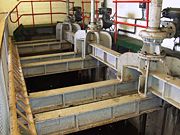 Jessop's original designs for the harbour included a dam with an 'overfall', with the level of the water determined by the height of the dam's crest. As a result of the accumulation of mud and silt in the harbour, ships entering the narrow harbour were frequently being grounded. In 1832 Brunel was called upon to provide the solution to this problem and designed the sluice system, still in use today, to remove excesses of foul-smelling silt and mud.
Jessop's original designs for the harbour included a dam with an 'overfall', with the level of the water determined by the height of the dam's crest. As a result of the accumulation of mud and silt in the harbour, ships entering the narrow harbour were frequently being grounded. In 1832 Brunel was called upon to provide the solution to this problem and designed the sluice system, still in use today, to remove excesses of foul-smelling silt and mud.
In place of the Overfall he constructed three shallow sluice
s and one deep scouring sluice, between the harbour and the New Cut, together with a dredging vessel, known as a drag boat, to scrape the silt away from the quay walls. Sluices 1 and 2 ('shallow') are used to control the water level, while sluices 3 and 4 ('deep') remove the silt. When the deep sluices are opened at low tide, a powerful undertow
is created which sucks the silt out of the harbour and into the river. In March 1988, the sluice control was computerised and automated.
as listed buildings.
The original blacksmiths' and engineering workshops remain in use while the shipwrights' shop is now used as a carpentry workshop.
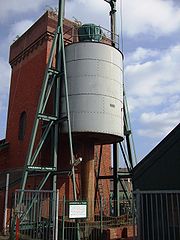 The octagonal brick
The octagonal brick
and terracotta chimney
of the engine house dates from 1888, and is grade II* listed, as is the hydraulic engine house itself. It replaced the original pumping house which is now The Pump House
public house
. It is built of red brick with a slate roof and originally contained two steam engines. These were replaced in 1907 by the current electric machines from Fullerton, Hodgart and Barclay of Paisley
. It powers the docks hydraulic system of cranes, bridges and locks.
The tower houses an hydraulic accumulator
which stores the hydraulic energy ensuring a smooth delivery of pressure and meaning that the pumps do not need to be running the whole time. The external accumulator was added about 1920. The water is pumped from the harbour into a header tank and then fed by gravity to the pumps. The working pressure is 750 lbf/in² (5.2 MPa).
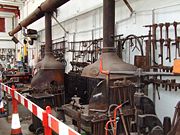 The dock maintenance workshops are also survivors from the 1880s but were extended in the early 20th century. The brick building is topped with a tiled double-pile hipped roof
The dock maintenance workshops are also survivors from the 1880s but were extended in the early 20th century. The brick building is topped with a tiled double-pile hipped roof
with corbel
led eaves. It has sliding doors at each end, giving access to the boiler and engine houses, blacksmith's and engineer's shops. Much of the original machinery survives, including steam-powered plant from the mid 1880s, these include a Whitworth
planing machine
, a Whitworth slotting machine, punching-and-shearing machines, a long-bed lathe
and a steam hammer
. There is also wall-mounted line-shafting and a Tangye
horizontal engine and Cornish boiler.
shop and stores date from the same period and are grade II listed,
The shop is currently occupied by RB Boatbuilding Ltd, a small business dedicated to the re-creation of classic, late 19th century, wooden working boats, including the Bristol Channel Pilot Cutter. The Slipway Co-operative
Ltd manages the slipping of boats. They build, repair and restore a variety of wooden craft including the 14 feet (4 m) Bristol Jolly Boat.
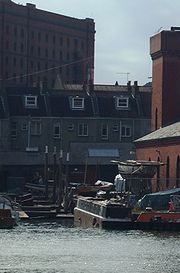 The original slipway was built by John Ward Girdlestone in 1890 which had replaced a predecessor built in the 1850s by boatbuilders Ross and Sage. It used a system in which the ship is floated onto the cradle and secured. The cradle is then drawn out of the water with a steam-driven winch
The original slipway was built by John Ward Girdlestone in 1890 which had replaced a predecessor built in the 1850s by boatbuilders Ross and Sage. It used a system in which the ship is floated onto the cradle and secured. The cradle is then drawn out of the water with a steam-driven winch
. The device was a low-cost alternative to dry docks for maintenance and repair work. This became known as the Patent Slipway
or 'Heave-up Slip' and was patented in 1819 by shipbuilder Thomas Morton
of Leith
in Scotland
.
The 1890 replacement was originally driven by an hydraulic engine powered by the dock's hydraulic system. In 1924, an electric motor was installed which still operates today. The Bristol slipway is relatively small with a cradle of 100 feet (30 m) and a runway of 265 feet (81 m) and could lift vessels up to 250 tons (250 tonnes).
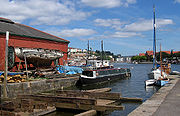 It fell into disuse by 1974. By the 1990s this was becoming rotted and was rebuilt by members of the Slipway Co-operative and Underfall Trust in 1998-99. The restoration required the complete renewal of the underwater runway with steel piling to replace the previous timber, iron and masonry supports. The above-water track was re-laid, reusing the original cast iron
It fell into disuse by 1974. By the 1990s this was becoming rotted and was rebuilt by members of the Slipway Co-operative and Underfall Trust in 1998-99. The restoration required the complete renewal of the underwater runway with steel piling to replace the previous timber, iron and masonry supports. The above-water track was re-laid, reusing the original cast iron
centre rails with their integral ratchets
. The cradle was completely rebuilt on the original pattern. The functioning of the slipway was essential for the long-term preservation of the restored Underfall Yard as a historic industrial monument, as it provided the Underfall Restoration Trust with funds to maintain slipway and buildings, and the tenants of those buildings with boats to earn a living.
powered by the engine in the machine shop. It is now used as a carpentry
shop.
, fabricating and hull repairs. In addition, gates, railings, security grilles and ornamental iron work are also made from stainless steel
, steel
, aluminum and wrought iron
.
Spike Island, Bristol
Spike Island is an area of the English port city of Bristol, adjoining the city centre. It comprises the strip of land between the Floating Harbour to the north and the tidal New Cut of the River Avon to the south, from the dock entrance to the west to Bathurst Basin in the east...
serving Bristol Harbour
Bristol Harbour
Bristol Harbour is the harbour in the city of Bristol, England. The harbour covers an area of . It has existed since the 13th century but was developed into its current form in the early 19th century by installing lock gates on a tidal stretch of the River Avon in the centre of the city and...
, the harbour in the city of Bristol
Bristol
Bristol is a city, unitary authority area and ceremonial county in South West England, with an estimated population of 433,100 for the unitary authority in 2009, and a surrounding Larger Urban Zone with an estimated 1,070,000 residents in 2007...
, England
England
England is a country that is part of the United Kingdom. It shares land borders with Scotland to the north and Wales to the west; the Irish Sea is to the north west, the Celtic Sea to the south west, with the North Sea to the east and the English Channel to the south separating it from continental...
.
Underfall Yard was commonly referred to as "The Underfalls" and takes its name from the underfall sluices. The original construction was in the early 19th century with revisions by Isambard Kingdom Brunel
Isambard Kingdom Brunel
Isambard Kingdom Brunel, FRS , was a British civil engineer who built bridges and dockyards including the construction of the first major British railway, the Great Western Railway; a series of steamships, including the first propeller-driven transatlantic steamship; and numerous important bridges...
in the 1830s.
Following restoration in the 1990s, this Victorian
Victorian era
The Victorian era of British history was the period of Queen Victoria's reign from 20 June 1837 until her death on 22 January 1901. It was a long period of peace, prosperity, refined sensibilities and national self-confidence...
work yard is now a Scheduled Monument that includes several listed buildings. The harbour and its equipment are still actively maintained, and host a cooperative of boat builders.

History
In the early nineteenth century, the engineer William JessopWilliam Jessop
William Jessop was an English civil engineer, best known for his work on canals, harbours and early railways in the late 18th and early 19th centuries.-Early life:...
was engaged by the Bristol Dock Company to create a non-tidal Floating Harbour to combat continuing problems with ships being grounded at low tide. With his system, which was completed in 1809, water was trapped behind lock gates so ships could remain floating at all times, unaffected by the state of the tide on the river. Part of the project included building a dam
Dam
A dam is a barrier that impounds water or underground streams. Dams generally serve the primary purpose of retaining water, while other structures such as floodgates or levees are used to manage or prevent water flow into specific land regions. Hydropower and pumped-storage hydroelectricity are...
at the Underfall Yard with a weir
Weir
A weir is a small overflow dam used to alter the flow characteristics of a river or stream. In most cases weirs take the form of a barrier across the river that causes water to pool behind the structure , but allows water to flow over the top...
to allow surplus river water to flow into the New Cut
New Cut (Bristol)
The New Cut is an artificial waterway which was constructed between 1804 and 1809 to divert the tidal river Avon through south and east Bristol, England. This was part of the process of constructing Bristol's Floating Harbour, under the supervision of engineer William Jessop...
, an excavation that by-passed the Floating Harbour and joined the River Avon
River Avon, Bristol
The River Avon is an English river in the south west of the country. To distinguish it from a number of other River Avons in Britain, this river is often also known as the Lower Avon or Bristol Avon...
near Temple Meads.
The docks' maintenance facility was established on the land exposed by the damming of the river to construct the harbour and remains sited at this location to the present day.
By the 1830s the Floating Harbour was suffering from severe silting and Isambard Kingdom Brunel
Isambard Kingdom Brunel
Isambard Kingdom Brunel, FRS , was a British civil engineer who built bridges and dockyards including the construction of the first major British railway, the Great Western Railway; a series of steamships, including the first propeller-driven transatlantic steamship; and numerous important bridges...
devised the underfall sluices as a solution.
The Bristol Docks Company never achieved commercial success and was taken over by Bristol City Council in 1848. In 1880 the Council bought the Slipway
Slipway
A slipway, boat slip or just a slip, is a ramp on the shore by which ships or boats can be moved to and from the water. They are used for building and repairing ships and boats. They are also used for launching and retrieving small boats on trailers and flying boats on their undercarriage. The...
and yard to enlarge the docks' maintenance facilities.
The 'Underfall' system was re-built in the 1880s, with longer sluices, and the yard above was enlarged. Brunel's method of silt disposal is still in operation today, but the silt is carried in mud barges or pumped to the sluices through a quayside pipe system from the more efficient modern 'Cutter-Suction' dredgers.
During the 20th century the western parts of the yard were leased to P & A Campbell Ltd
P and A Campbell
P & A Campbell Ltd of Bristol with its White Funnel Fleet became the dominant excursion-steamer operator in the Bristol Channel by the 1890s; and along the South Coast of England in the first half of the twentieth century.-The White Funnel fleet:...
, operators of the White Funnel Line of paddle steamers as a maintenance base. The yards have been little altered recently except for the replacement of the three-storey 'A' block over the sluice paddle room resulting from bomb damage in World War II
World War II
World War II, or the Second World War , was a global conflict lasting from 1939 to 1945, involving most of the world's nations—including all of the great powers—eventually forming two opposing military alliances: the Allies and the Axis...
.
Underfall Yard has been refurbished under the management of the Underfall Restoration Trust thanks to Lottery
National Lottery (United Kingdom)
The National Lottery is the state-franchised national lottery in the United Kingdom and the Isle of Man.It is operated by Camelot Group, to whom the licence was granted in 1994, 2001 and again in 2007. The lottery is regulated by the National Lottery Commission, and was established by the then...
money, European
European Union
The European Union is an economic and political union of 27 independent member states which are located primarily in Europe. The EU traces its origins from the European Coal and Steel Community and the European Economic Community , formed by six countries in 1958...
funding and financial support from Bristol City Council. Since the 1990s £500,000 has been spent on regenerating the slip and restoring buildings around the boatyard.
Based at the yard at the moment are two wooden boat builders, a blacksmith
Blacksmith
A blacksmith is a person who creates objects from wrought iron or steel by forging the metal; that is, by using tools to hammer, bend, and cut...
, a ship rigger
Rigger
Rigger may refer to:* One who attends to the rigging of a sailing ship* Rigger , those who tend rigging in stage performance * Rigger , specializing in moving large/heavy objects* Parachute rigger...
, a composites specialist (GRP, Carbonfibre), a narrow boat outfitter and a joiner
Joiner
A joiner differs from a carpenter in that joiners cut and fit joints in wood that do not use nails. Joiners usually work in a workshop since the formation of various joints generally requires non-portable machinery. A carpenter normally works on site...
.
Underfall sluices

In place of the Overfall he constructed three shallow sluice
Sluice
A sluice is a water channel that is controlled at its head by a gate . For example, a millrace is a sluice that channels water toward a water mill...
s and one deep scouring sluice, between the harbour and the New Cut, together with a dredging vessel, known as a drag boat, to scrape the silt away from the quay walls. Sluices 1 and 2 ('shallow') are used to control the water level, while sluices 3 and 4 ('deep') remove the silt. When the deep sluices are opened at low tide, a powerful undertow
Undertow (wave action)
Undertow is a subsurface flow of water returning seaward from shore as result of wave action. This type of shore current can play a role in material deposition such as creating sand bars....
is created which sucks the silt out of the harbour and into the river. In March 1988, the sluice control was computerised and automated.
Buildings
Most of the buildings and engineering installations at the yard were constructed between 1880 and 1890 under the direction of John Ward Girdlestone. Many of them have been designated by English HeritageEnglish Heritage
English Heritage . is an executive non-departmental public body of the British Government sponsored by the Department for Culture, Media and Sport...
as listed buildings.
The original blacksmiths' and engineering workshops remain in use while the shipwrights' shop is now used as a carpentry workshop.
Hydraulic Engine House

Brick
A brick is a block of ceramic material used in masonry construction, usually laid using various kinds of mortar. It has been regarded as one of the longest lasting and strongest building materials used throughout history.-History:...
and terracotta chimney
Chimney
A chimney is a structure for venting hot flue gases or smoke from a boiler, stove, furnace or fireplace to the outside atmosphere. Chimneys are typically vertical, or as near as possible to vertical, to ensure that the gases flow smoothly, drawing air into the combustion in what is known as the...
of the engine house dates from 1888, and is grade II* listed, as is the hydraulic engine house itself. It replaced the original pumping house which is now The Pump House
Pump House, Bristol
The Pump House is an historic public house situated in Hotwells on Bristol Harbour, Bristol, England.It was built around 1870 by Thomas Howard as a Hydraulic Pumping House to provide power to the bridges and machines of Bristol Harbour. It was replaced by the current Hydraulic engine house in the...
public house
Public house
A public house, informally known as a pub, is a drinking establishment fundamental to the culture of Britain, Ireland, Australia and New Zealand. There are approximately 53,500 public houses in the United Kingdom. This number has been declining every year, so that nearly half of the smaller...
. It is built of red brick with a slate roof and originally contained two steam engines. These were replaced in 1907 by the current electric machines from Fullerton, Hodgart and Barclay of Paisley
Paisley
Paisley is the largest town in the historic county of Renfrewshire in the west central Lowlands of Scotland and serves as the administrative centre for the Renfrewshire council area...
. It powers the docks hydraulic system of cranes, bridges and locks.
The tower houses an hydraulic accumulator
Hydraulic accumulator
A 'hydraulic accumulator' is an energy storage device. It is a pressure storage reservoir in which a non-compressible hydraulic fluid is held under pressure by an external source. That external source can be a spring, a raised weight, or a compressed gas...
which stores the hydraulic energy ensuring a smooth delivery of pressure and meaning that the pumps do not need to be running the whole time. The external accumulator was added about 1920. The water is pumped from the harbour into a header tank and then fed by gravity to the pumps. The working pressure is 750 lbf/in² (5.2 MPa).
Dock maintenance workshops

Hip roof
A hip roof, or hipped roof, is a type of roof where all sides slope downwards to the walls, usually with a fairly gentle slope. Thus it is a house with no gables or other vertical sides to the roof. A square hip roof is shaped like a pyramid. Hip roofs on the houses could have two triangular side...
with corbel
Corbel
In architecture a corbel is a piece of stone jutting out of a wall to carry any superincumbent weight. A piece of timber projecting in the same way was called a "tassel" or a "bragger". The technique of corbelling, where rows of corbels deeply keyed inside a wall support a projecting wall or...
led eaves. It has sliding doors at each end, giving access to the boiler and engine houses, blacksmith's and engineer's shops. Much of the original machinery survives, including steam-powered plant from the mid 1880s, these include a Whitworth
Armstrong Whitworth
Sir W G Armstrong Whitworth & Co Ltd was a major British manufacturing company of the early years of the 20th century. Headquartered in Elswick, Newcastle upon Tyne, Armstrong Whitworth engaged in the construction of armaments, ships, locomotives, automobiles, and aircraft.-History:In 1847,...
planing machine
Planer (metalworking)
A planer is a type of metalworking machine tool that uses linear relative motion between the workpiece and a single-point cutting tool to machine a linear toolpath. Its cut is analogous to that of a lathe, except that it is linear instead of helical...
, a Whitworth slotting machine, punching-and-shearing machines, a long-bed lathe
Lathe
A lathe is a machine tool which rotates the workpiece on its axis to perform various operations such as cutting, sanding, knurling, drilling, or deformation with tools that are applied to the workpiece to create an object which has symmetry about an axis of rotation.Lathes are used in woodturning,...
and a steam hammer
Steam hammer
A steam hammer is a power-driven hammer used to shape forgings. It consists of a hammer-like piston located within a cylinder. The hammer is raised by the pressure of steam injected into the lower part of a cylinder and falls down with a force by removing the steam. Usually, the hammer is made to...
. There is also wall-mounted line-shafting and a Tangye
Richard Tangye
Sir Richard Trevithick Tangye was a British manufacturer of engines and other heavy equipment.-Biography:...
horizontal engine and Cornish boiler.
Pattern maker's shop
The former pattern-maker'sPattern (casting)
In casting, a pattern is a replica of the object to be cast, used to prepare the cavity into which molten material will be poured during the casting process.Patterns used in sand casting may be made of wood, metal, plastics or other materials...
shop and stores date from the same period and are grade II listed,
The shop is currently occupied by RB Boatbuilding Ltd, a small business dedicated to the re-creation of classic, late 19th century, wooden working boats, including the Bristol Channel Pilot Cutter. The Slipway Co-operative
Slipway Co-operative
The Slipway Co-operative Ltd is a boat building and restoration company based at the Underfall Yard in Bristol, England.The Co-operative was founded in 2002 by Win Cnoops, and the company undertakes the build of new, and repairs and restores timber yachts and motorboats...
Ltd manages the slipping of boats. They build, repair and restore a variety of wooden craft including the 14 feet (4 m) Bristol Jolly Boat.
Slipway

Winch
A winch is a mechanical device that is used to pull in or let out or otherwise adjust the "tension" of a rope or wire rope . In its simplest form it consists of a spool and attached hand crank. In larger forms, winches stand at the heart of machines as diverse as tow trucks, steam shovels and...
. The device was a low-cost alternative to dry docks for maintenance and repair work. This became known as the Patent Slipway
Patent slip
The patent slip or Marine Railway was invented by Scot Thomas Morton in 1818 as a cheaper alternative to a dry dock for ship repair. It consisted of an inclined plane, which extended well into the water, and a wooden cradle onto which a ship was floated...
or 'Heave-up Slip' and was patented in 1819 by shipbuilder Thomas Morton
Thomas Morton (shipwright)
Thomas Morton was a Scottish shipwright and inventor. His most widely known invention is the patent slip.-Biography:Morton was born in Leith in October 1781 and grew up to become a shipwright like his father, Hugh...
of Leith
Leith
-South Leith v. North Leith:Up until the late 16th century Leith , comprised two separate towns on either side of the river....
in Scotland
Scotland
Scotland is a country that is part of the United Kingdom. Occupying the northern third of the island of Great Britain, it shares a border with England to the south and is bounded by the North Sea to the east, the Atlantic Ocean to the north and west, and the North Channel and Irish Sea to the...
.
The 1890 replacement was originally driven by an hydraulic engine powered by the dock's hydraulic system. In 1924, an electric motor was installed which still operates today. The Bristol slipway is relatively small with a cradle of 100 feet (30 m) and a runway of 265 feet (81 m) and could lift vessels up to 250 tons (250 tonnes).

Cast iron
Cast iron is derived from pig iron, and while it usually refers to gray iron, it also identifies a large group of ferrous alloys which solidify with a eutectic. The color of a fractured surface can be used to identify an alloy. White cast iron is named after its white surface when fractured, due...
centre rails with their integral ratchets
Ratchet (device)
A ratchet is a device that allows continuous linear or rotary motion in only one direction while preventing motion in the opposite direction. Because most socket wrenches today use ratcheting handles, the term "ratchet" alone is often used to refer to a ratcheting wrench, and the terms "ratchet"...
. The cradle was completely rebuilt on the original pattern. The functioning of the slipway was essential for the long-term preservation of the restored Underfall Yard as a historic industrial monument, as it provided the Underfall Restoration Trust with funds to maintain slipway and buildings, and the tenants of those buildings with boats to earn a living.
Shipwright's shop
The shipwrights' shop dates from 1885 when it contained a mortar mill and circular sawCircular saw
The circular saw is a machine using a toothed metal cutting disc or blade. The term is also loosely used for the blade itself. The blade is a tool for cutting wood or other materials and may be hand-held or table-mounted. It can also be used to make narrow slots...
powered by the engine in the machine shop. It is now used as a carpentry
Carpentry
A carpenter is a skilled craftsperson who works with timber to construct, install and maintain buildings, furniture, and other objects. The work, known as carpentry, may involve manual labor and work outdoors....
shop.
Waterside Forge
The Waterside Forge workshop can be found within Underfall Yard, alongside the slipway. The forge offers weldingWelding
Welding is a fabrication or sculptural process that joins materials, usually metals or thermoplastics, by causing coalescence. This is often done by melting the workpieces and adding a filler material to form a pool of molten material that cools to become a strong joint, with pressure sometimes...
, fabricating and hull repairs. In addition, gates, railings, security grilles and ornamental iron work are also made from stainless steel
Stainless steel
In metallurgy, stainless steel, also known as inox steel or inox from French "inoxydable", is defined as a steel alloy with a minimum of 10.5 or 11% chromium content by mass....
, steel
Steel
Steel is an alloy that consists mostly of iron and has a carbon content between 0.2% and 2.1% by weight, depending on the grade. Carbon is the most common alloying material for iron, but various other alloying elements are used, such as manganese, chromium, vanadium, and tungsten...
, aluminum and wrought iron
Wrought iron
thumb|The [[Eiffel tower]] is constructed from [[puddle iron]], a form of wrought ironWrought iron is an iron alloy with a very low carbon...
.

